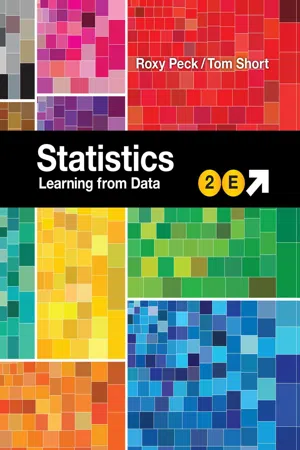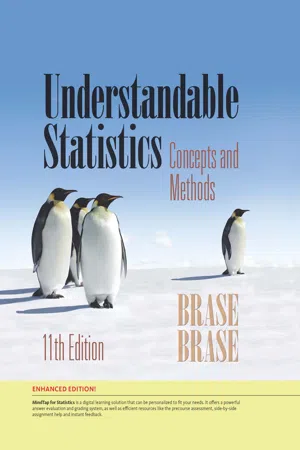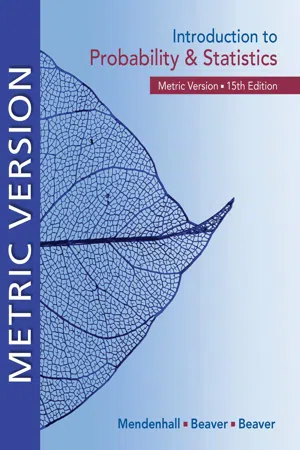Mathematics
Bar Graphs
Bar graphs are a visual representation of data using bars of different heights or lengths to show the frequency or distribution of categories. The length or height of each bar corresponds to the value it represents. They are commonly used to compare and contrast different categories or to track changes over time.
Written by Perlego with AI-assistance
Related key terms
1 of 5
12 Key excerpts on "Bar Graphs"
- David Anderson, Dennis Sweeney, Thomas Williams, Jeffrey Camm(Authors)
- 2020(Publication Date)
- Cengage Learning EMEA(Publisher)
All Rights Reserved. May not be copied, scanned, or duplicated, in whole or in part. Due to electronic rights, some third party content may be suppressed from the eBook and/or eChapter(s). Editorial review has deemed that any suppressed content does not materially affect the overall learning experience. Cengage Learning reserves the right to remove additional content at any time if subsequent rights restrictions require it. 40 Chapter 2 Descriptive Statistics: Tabular and Graphical Displays Bar Charts and Pie Charts A bar chart is a graphical display for depicting categorical data summarized in a frequency, relative frequency, or percent frequency distribution. On one axis of the graph we specify the labels that are used for the classes (categories). A frequency, relative frequency, or percent frequency scale can be used for the other axis of the chart. Then, using a bar of fixed width drawn above or next to each class label, we extend the length of the bar until we reach the frequency, relative frequency, or percent frequency of the class. For categorical data, the bars should be separated to emphasize the fact that each class is separate. Figure 2.3 shows a bar chart of the frequency distribution for the 50 soft FIGURE 2.2 Relative Frequency and Percent Frequency Distributions of Soft Drink Purchases Constructed Using Excel’s Recommended PivotTables Tool FIGURE 2.3 Bar Chart of Soft Drink Purchases Frequency Soft Drink Coca-Cola Diet Coke Dr. Pepper Pepsi Sprite 20 0 2 4 6 8 10 12 14 16 18 Copyright 2020 Cengage Learning. All Rights Reserved. May not be copied, scanned, or duplicated, in whole or in part. Due to electronic rights, some third party content may be suppressed from the eBook and/or eChapter(s). Editorial review has deemed that any suppressed content does not materially affect the overall learning experience. Cengage Learning reserves the right to remove additional content at any time if subsequent rights restrictions require it.- eBook - PDF
- John Peterson, Robert Smith(Authors)
- 2018(Publication Date)
- Cengage Learning EMEA(Publisher)
Statistical data are often time-consuming and difficult to interpret. Graphs present data in simple and concise picture form. Data, when graphed, often can be interpreted more quickly and are easier to understand. The Cartesian coordinate system was studied in Unit 16, The Cartesian Coordi-nate System and Graphs of Linear Equations . Now, three different types of graphs will be shown. Bar Graphs, circle graphs or charts, and line graphs are three common ways of picturing statistical data. These three types of graphs can be seen on television, in magazines, books, and manuals, and, almost everyday, in newspapers. 31–1 TYPES AND STRUCTURE OF GRAPHS Many kinds of graphs are designed for special-purpose applications. An understanding of basic graphs, such as Bar Graphs, circle graphs and line graphs, provides a background for the reading and construction of other more specialized graphs. Circle graphs are constructed with the use of a protractor. Protractors were discussed in Unit 20, Angular Measure . UNIT 31 GRAPHS: BAR, CIRCLE, AND LINE Copyright 2019 Cengage Learning. All Rights Reserved. May not be copied, scanned, or duplicated, in whole or in part. Due to electronic rights, some third party content may be suppressed from the eBook and/or eChapter(s). Editorial review has deemed that any suppressed content does not materially affect the overall learning experience. Cengage Learning reserves the right to remove additional content at any time if subsequent rights restrictions require it. Unit 31 GRAPHS: BAR, CIRCLE, AND LINE 751 Bar Graphs are used to compare quantities. The bars can be either horizontal or ver-tical, with the length or height of the bar representing the quantity. The quantities do not have to add up to 100%. One variation of the bar graph is the stacked bar graph. In a stacked bar graph each bar is divided into sub-parts. 31–2 Bar Graphs Graph paper, which is also called coordinate and cross-section paper, is used for graphing data. - eBook - PDF
Statistics
Learning from Data
- Roxy Peck, Tom Short(Authors)
- 2018(Publication Date)
- Cengage Learning EMEA(Publisher)
Due to electronic rights, some third party content may be suppressed from the eBook and/or eChapter(s). Editorial review has deemed that any suppressed content does not materially affect the overall learning experience. Cengage Learning reserves the right to remove additional content at any time if subsequent rights restrictions require it. CHAPTER 2 Graphical Methods for Describing Data Distributions 54 the scale on the vertical axis and that the overall picture of the distribution provided is unchanged. One advantage of the relative frequency bar chart is that the heights of the bars can be interpreted in terms of proportions or percentages. The bar chart provides a visual representation of the distribution of the 806 values that make up the data set. From the bar chart, it is easy to see that the compliant helmet category occurred most often in the data set. The bar for compliant helmets is about two times as tall (and therefore has about two times the area) as the bar for no helmet because approximately two times as many motorcyclists wore compliant helmets than wore no helmet. Comparative Bar Charts Bar charts can also be used to provide a visual comparison of two or more groups. This is accomplished by constructing two or more bar charts that use the same set of horizontal and vertical axes. Comparative Bar Chart When to Use Number of variables: 1 variable with observations for two or more groups Data type: categorical Purpose: comparing two or more data distributions A comparative bar chart is constructed by using the same horizontal and vertical axes for the bar charts of two or more groups. The bar charts are usually color-coded to indicate which bars correspond to each group. For comparative bar charts, relative frequency should be used for the vertical axis so that you can make meaningful comparisons even if the sample sizes are not the same. - eBook - PDF
- Dawn A. Willoughby(Author)
- 2016(Publication Date)
- Wiley(Publisher)
It is also important that diagrams are drawn carefully and accurately so that the audience does not misinterpret their meaning because of the way in which the data are presented. Bar Charts Qualitative data are often displayed using a bar chart. This is a diagram drawn with rectangular bars where each bar represents a different category in the data set. Categories are labelled on one axis and the frequency of the category on the other. The bars in the chart should be the same width and separated an equal distance from each other. Bars can be drawn horizontally or vertically, and the frequency of the category is represented by the length or height of the corresponding bar. Horizontal bar charts are particularly useful if category names are lengthy. The following bar charts show the number of small, medium and large portions of chips sold in a single hour at a fast food restaurant. Each chart shows the same data – one using vertical bars, the other using horizontal bars. 0 20 40 60 80 100 small medium large number of portions sold size of portion Sales of chips in a fast-food restaurant 0 20 40 60 80 100 small medium large number of portions sold size of portion Sales of chips in a fast-food restaurant From these bar charts, we can see that: • the most popular portion size was medium; • half as many small portions of chips were sold compared to large; • 60 large portions of chips were sold. The scale on a bar chart must always be carefully drawn, starting at zero, so that the diagram provides an accurate picture of the data it is representing. The example below shows how changing the scale can give a false impression of the data set. 86 A N E S S E N T I A L G U I D E T O B U S I N E S S S T A T I S T I C S In a trial of new milkshake flavours, 300 customers were asked to taste a sample of each flavour and record their favourite. - No longer available |Learn more
Single Case Research Methodology
Applications in Special Education and Behavioral Sciences
- Jennifer R. Ledford, David L. Gast, Jennifer R. Ledford, David L. Gast(Authors)
- 2018(Publication Date)
- Taylor & Francis(Publisher)
Visual Representation of Data • 161 Figure 7.2 Graph showing one simple line graph on which the dependent variable (% compliance) is measured at varying integrity levels across one student. Source: Wilder, D. A., Atwell, J., &Wine, B. (2006). The effects of varying levels of treatment integrity on child compliance during treatment with a three-step prompting procedure. Journal of Applied Behavior Analysis, 39, 369–373. used to present summative level data rather than changes over time (which should be pre- sented via line graph; for a review of line graph versus bar graph interpretation, see Shah & Hoeffner, 2002). Bar Graphs are also helpful for displaying categorical data related to narra- tive reviews of SCD data (e.g., the number of participants of given age ranges included in reviewed studies). As shown in Figure 7.4, a bar graph can be used to summarize a student’s performance or behavior on a pre- and post-test measure of a generalized tendency, before and after introducing an intervention for improving social interactions among peers, within the context of an SCD. A variation of a simple bar graph is the subdivided bar graph. Figure 7.5 uses the subdivided bar graph format to indicate the mean percentages of sedentary, light, moderate, and vigorous physical activity of a child with autism spectrum disorder on the playground. This method of plotting summarizes the magnitude of target behavior with a single bar, which permits a quick and easy comparison of data, in addition to conserving space. Bar Graphs provide a simple and straightforward summary of data that are easily understood and analyzed. Though they are not recommended for displaying continuous data, they repre- sent an excellent format for displaying and communicating important comparisons in a final research report or literature review. In their construction, it is important to remember to keep the width of each bar identical and thus not perceptually mislead readers. - eBook - PDF
- Roxy Peck, Chris Olsen, , Tom Short, Roxy Peck, Chris Olsen, Tom Short(Authors)
- 2019(Publication Date)
- Cengage Learning EMEA(Publisher)
● ● How a graphical display of numerical data is described in terms of center, shape, and spread. ● ● How a scatterplot is used to investigate the relationship between two numerical variables. ● ● How a time series plot is used to investigate a trend over time. Students will be able to: ● ● Construct and interpret graphical displays of categorical data: pie charts and seg-mented bar charts. istock.com/florintt 9,179 6,880 9,884 7,577 9,070 9,128 11,106 11,670 4,438 7,011 9,263 6,915 13,387 8,745 7,879 8,011 9,490 8,162 9,186 8,942 11,670 11,708 10,701 7,175 8,178 6,443 7,446 5,298 14,986 13,021 6,262 7,647 6,944 7,208 9,757 6,680 9,406 13,516 11,321 11,791 8,273 8,932 8,091 6,140 15,062 11,669 7,782 6,900 8,504 4,179 Copyright 2020 Cengage Learning. All Rights Reserved. May not be copied, scanned, or duplicated, in whole or in part. Due to electronic rights, some third party content may be suppressed from the eBook and/or eChapter(s). Editorial review has deemed that any suppressed content does not materially affect the overall learning experience. Cengage Learning reserves the right to remove additional content at any time if subsequent rights restrictions require it. CHAPTER 3 Graphical Methods for Describing Data 78 ● ● Construct and interpret graphical displays of numerical data: stem-and-leaf displays, histograms, and relative frequency histograms. ● ● Construct and interpret graphical displays designed to compare groups: comparative bar charts and comparative stem-and-leaf displays. ● ● Construct and interpret a scatterplot of bivariate numerical data. ● ● Construct and interpret a time series plot. SECTION 3.1 Displaying Categorical Data: Comparative Bar Charts and Pie Charts Comparative Bar Charts In Chapter 1 we saw that categorical data could be summarized in a frequency distribu-tion and displayed graphically using a bar chart. Bar charts can also be used to give a visual comparison of two or more groups. - Bruce M. King, Patrick J. Rosopa, Edward W. Minium(Authors)
- 2018(Publication Date)
- Wiley(Publisher)
The general public seems to find a histogram a little easier to understand than a polygon, and hence it may be a good choice for communicating with them. A histogram also has some merit when displaying relative frequency. The total area in a his- togram represents 100% of the scores, and, thus, the area in the bars of a histogram is directly representative of relative frequency. That is, the area in any rectangle is the same fraction of the total area of the histogram as the frequency of that class interval is of the total number of cases in the distribution. FIGURE 3.4 Histograms are often used when graphing ungrouped distributions of a discrete variable. (Source: Taken from ACT Class Profile Report, high school graduates 2013, 2014, and 2015. Copyright by ACT, Inc. Reproduced with permission.) Relative frequency (%) 0 36 31 26 21 16 11 6 1 National high school graduate profile for ACT mathematics scores, 2013–2015 1 2 3 4 5 6 7 8 9 10 11 12 3.5 The Bar Diagram and the Pie Chart 37 Relative frequency (%) 0 55 52 58 61 64 67 70 73 History midterm exam scores 76 79 82 85 88 91 94 97 2 4 6 8 10 12 14 16 18 20 Distribution A Distribution B (n = 50) (n = 80) FIGURE 3.5 Relative frequency polygons used to compare the two score distributions in Table 2.7. A polygon is often preferred for grouped frequency distributions. Representing frequencies by rectangular bars suggests that the scores are evenly distributed within each class interval and that the borders of the intervals are points of decided change. If a definite trend of increasing or decreasing frequency exists over a span of several consecutive class intervals, the frequency polygon will show this trend more directly. This is because the direction of each straight line in the polygon is determined by the frequencies in two adjacent class intervals, whereas the horizontal top of each rectangle in a histogram is responsive only to what occurs in one class interval.- Brase/Brase, Charles Henry Brase, Corrinne Pellillo Brase(Authors)
- 2016(Publication Date)
- Cengage Learning EMEA(Publisher)
In which interval do most of the states fall? 24. Dotplot: Dog Sled Racing Make a dotplot for the data in Problem 15 re-garding the finish time (number of hours) for the Iditarod Dog Sled Race. Compare the dotplot to the histogram of Problem 15. 25. Dotplot: Tumor Recurrence Make a dotplot for the data in Problem 17 re-garding the recurrence of tumors after chemotherapy. Compare the dotplot to the histogram of Problem 17. Bar Graphs, Circle Graphs, and Time-Series Graphs FOCUS POINTS • Determine types of graphs appropriate for specific data. • Construct Bar Graphs, Pareto charts, circle graphs, and time-series graphs. • Interpret information displayed in graphs. Histograms provide a useful visual display of the distribution of data. However, the data must be quantitative. In this section, we examine other types of graphs, some of which are suitable for qualitative or category data as well. Let’s start with Bar Graphs . These are graphs that can be used to display quanti-tative or qualitative data. SECTION 2.2 Bar graph Source: U.S. Department of Transportation Copyright 2017 Cengage Learning. All Rights Reserved. May not be copied, scanned, or duplicated, in whole or in part. Due to electronic rights, some third party content may be suppressed from the eBook and/or eChapter(s). Editorial review has deemed that any suppressed content does not materially affect the overall learning experience. Cengage Learning reserves the right to remove additional content at any time if subsequent rights restrictions require it. 60 Chapter 2 ORGANIZING DATA FEATURES OF A BAR GRAPH 1. Bars can be vertical or horizontal. 2. Bars are of uniform width and uniformly spaced. 3. The lengths of the bars represent values of the variable being displayed, the fre-quency of occurrence, or the percentage of occurrence. The same measurement scale is used for the length of each bar.- David Anderson, Dennis Sweeney, Thomas Williams, Jeffrey Camm(Authors)
- 2019(Publication Date)
- Cengage Learning EMEA(Publisher)
To construct a pie chart, we first draw a circle to represent all the data. Then we use the relative frequencies to subdivide the circle into sectors, or parts, that correspond to the relative frequency for each class. For example, Copyright 2020 Cengage Learning. All Rights Reserved. May not be copied, scanned, or duplicated, in whole or in part. Due to electronic rights, some third party content may be suppressed from the eBook and/or eChapter(s). Editorial review has deemed that any suppressed content does not materially affect the overall learning experience. Cengage Learning reserves the right to remove additional content at any time if subsequent rights restrictions require it. 38 Chapter 2 Descriptive Statistics: Tabular and Graphical Displays FIGURE 2.4 Three-Dimensional Pie Chart of Soft Drink Purchases FIGURE 2.3 Pie Chart of Soft Drink Purchases because a circle contains 360 degrees and Coca-Cola shows a relative frequency of .38, the sector of the pie chart labeled Coca-Cola consists of .38(360) = 136.8 degrees. The sector of the pie chart labeled Diet Coke consists of .16(360) = 57.6 degrees. Similar calculations for the other classes yield the pie chart in Figure 2.3. The numerical values shown for each sector can be frequencies, relative frequencies, or percent frequencies. Although pie charts are common ways of visualizing data, many data visualization experts do not recommend their use because people have difficulty perceiving differences in area. In most cases, a bar chart is superior to a pie chart for displaying categorical data. Numerous options involving the use of colors, shading, legends, text font, and three-dimensional perspectives are available to enhance the visual appearance of bar and pie charts. However, one must be careful not to overuse these options because they may not enhance the usefulness of the chart. For instance, consider the three-dimensional pie chart for the soft drink data shown in Figure 2.4.- No longer available |Learn more
Understandable Statistics
Concepts and Methods, Enhanced
- Charles Henry Brase, Corrinne Pellillo Brase(Authors)
- 2016(Publication Date)
- Cengage Learning EMEA(Publisher)
After completing this chapter, you will be able to an-swer the following questions. (a) Look at the graph in Figure 2-1(a). Is it essentially a bar graph? Explain. What are some of the flaws of Figure 2-1(a) as a bar graph? (b) Examine Figure 2-1(b), which shows the same informa-tion. Is it essentially a time-series graph? Explain. In what ways does the second graph seem to display the information in a clearer manner? (See Problem 5 of the Chapter 2 Review Problems.) For online student resources, visit the Brase/Brase, Understandable Statistics , 11th edition web site at http://www.cengage.com/statistics/brase11e FOCUS PROBLEM ORGANIZING DATA PREVIEW QUESTIONS What are histograms? When are they used? (SECTION 2.1) What are common distribution shapes? (SECTION 2.1) How can you select graphs appropriate for given data sets? (SECTION 2.2) How can you quickly order data and, at the same time, reveal the distribution shape? (SECTION 2.3) Vandystadt/Photo Researchers, Inc © iStockphoto.com/Sportstock Copyright 201 Cengage Learning. All Rights Reserved. May not be copied, scanned, or duplicated, in whole or in part. Due to electronic rights, some third party content may be suppressed from the eBook and/or eChapter(s). Editorial review has deemed that any suppressed content does not materially affect the overall learning experience. Cengage Learning reserves the right to remove additional content at any time if subsequent rights restrictions require it. 42 Chapter 2 ORGANIZING DATA Frequency Distributions, Histograms, and Related Topics FOCUS POINTS • Organize raw data using a frequency table. • Construct histograms, relative-frequency histograms, and ogives. • Recognize basic distribution shapes: uniform, symmetric, skewed, and bimodal. • Interpret graphs in the context of the data setting. FREQUENCY TABLES When we have a large set of quantitative data, it’s useful to organize it into smaller intervals or classes and count how many data values fall into each class. - eBook - PDF
Finite Mathematics
An Applied Approach
- Michael Sullivan(Author)
- 2011(Publication Date)
- Wiley(Publisher)
A bar graph will show the number or the percent of data that is in each category, while a pie chart will show only the percent of data in each category. 1 Construct a Bar Graph from Data EXAMPLE 1 Constructing a Bar Graph from Data For the fiscal year 2009 (October 2008–September 2009), the federal government spent a total of $3.5176 trillion. The breakdown of expenditures (in billions of dollars) is given in Table 1. Construct a bar graph of the data. Social Security, Medicare, and other retirement $1168.7 National defense, veterans, and foreign affairs $794.0 Net interest (interest on the public debt) $186.9 Physical, human, and community development $553.3 Social programs $741.2 Law enforcement and general government $73.5 TOTAL $3517.6 Source: U.S. Treasury Department. TABLE 1 9.2 Representing Qualitative Data Graphically: Bar Graphs; Pie Charts SOLUTION A horizontal axis is used to indicate each category of spending and a vertical axis is used to represent the amount spent in each category. For each category of spending we draw rectangles of equal width whose heights represent the amount spent in the category. The rectangles will not touch each other. See Figure 1. 510 Chapter 9 Statistics Social Security, Medicare, and other retirement National defense, veterans, and foreign affairs Net interest (interest on the public debt) Physical, human, and community development Social programs Law enforcement and general government 200 400 600 800 1000 1200 1400 0 Billions of dollars FIGURE 1 Spending Percent of Degree Measure Category (in billions) Total Spending of Sector* Social Security, Medicare, and other retirement $1168.7 33% 120° National defense, veterans, and foreign affairs $794.0 23% 81° Net interest (interest on the public debt) $186.9 5% 19° Physical, human, and community development $553.3 16% 57° Social programs $741.2 21% 76° Law enforcement and general government $73.5 2% 8° TOTAL $3517.6 * The data in column 4 do not add up to 360° due to rounding. - No longer available |Learn more
- William Mendenhall, Robert Beaver, Barbara Beaver, , William Mendenhall, Robert Beaver, Barbara Beaver(Authors)
- 2019(Publication Date)
- Cengage Learning EMEA(Publisher)
Can you explain why the histogram looks the way it does? As you continue to work through the exercises in this chapter, you will get better at rec-ognizing different types of data and at choosing the best graph to use. Remember that the type of graph you use is not as important as the interpretation that accompanies the picture. Look for these important features: • Location of the center of the data • Shape of the distribution of data • Unusual observations in the data set Using these features to guide you, you can interpret and compare sets of data using graphs, which are only the first of many statistical tools that you will soon have to work with. Copyright 2020 Cengage Learning. All Rights Reserved. May not be copied, scanned, or duplicated, in whole or in part. Due to electronic rights, some third party content may be suppressed from the eBook and/or eChapter(s). Editorial review has deemed that any suppressed content does not materially affect the overall learning experience. Cengage Learning reserves the right to remove additional content at any time if subsequent rights restrictions require it. 35 Technology Today Key Concepts I. How Data Are Generated 1. Experimental units, variables, and measurements 2. Samples and populations 3. Univariate, bivariate, and multivariate data II. Types of Variables 1. Qualitative or categorical 2. Quantitative a. Discrete b. Continuous III. Graphs for Univariate Data Distributions 1. Qualitative or categorical data a. Pie charts b. Bar charts 2. Quantitative data a. Pie and bar charts b. Line charts c. Dotplots d. Stem and leaf plots e. Relative frequency histograms 3. Describing data distributions a. Shapes—symmetric, skewed left, skewed right, unimodal, and bimodal b. Proportion of measurements in certain intervals c. Outliers CHAPTER REVIEW TECHNOLOGY TODAY Introduction to Microsoft Excel MS Excel is designed for a variety of applications, including statistical applications.
Index pages curate the most relevant extracts from our library of academic textbooks. They’ve been created using an in-house natural language model (NLM), each adding context and meaning to key research topics.











